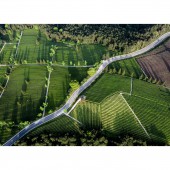Dingxin Tea Garden Commercial by Yiping Yu and Shuangwu He |
Home > Winners > #109635 |
 |
|
||||
| DESIGN DETAILS | |||||
| DESIGN NAME: Dingxin Tea Garden PRIMARY FUNCTION: Commercial INSPIRATION: Inspired by the environment, regional culture, connotation of tea culture, the idea of "unity of nature and human beings" and the construction essence of Chinese gardens, we integrate the mountain, water and tea together to form a space with life characteristics. By doing this, the seemingly randomly distributed architecture groups are united to form the most fascinating scenery of tea fields. UNIQUE PROPERTIES / PROJECT DESCRIPTION: With the design principles of ecology and harmony, the tea garden not only boasts aesthetic perception, but also integrates science, ecology and commerce. It embodies extensive and profound tea culture in tea planting, tea picking, tea making, tea watching and tea tasting, making itself the first tea industrial complex in Chongqing. The project presents a natural temperament of lightness with distance and fragrance with freshness, offering a secluded paradise with natural scenery for people. OPERATION / FLOW / INTERACTION: Dingxin Tea Garden, blessed with an excellent natural environment, is an elaborately designed promised land. It is quiet and natural with a fresh charm. Boiling and tasting tea in the tea mountain, you will feel "the dust is suddenly cleared, as if by the breeze that comes from your heart". Here, mountains, water and tea are blended into a harmonious and interdependent whole, forming a living space and the most beautiful scenery of tea fields. Picking, making and tasting tea, climbing the tea mountain and strolling around the tea fields, every visitor can get a sweeping view of verdant green and experience the authentic pastoral life. PROJECT DURATION AND LOCATION: The project finished in March 2018 in Ersheng Town, Chongqing. It covers an area of some 24,200 square meters. |
PRODUCTION / REALIZATION TECHNOLOGY: The design is made based on the following four aspects to create a unique modern mountain landscape architecture. 1. Water system layout: The architecture is built by the water and connected by water landscapes of different size. More attention is paid to the creation of water landscapes in the entrance space and people's experience of observing water landscapes from different dimensions while walking in the architecture. 2. View of the mountain: The shape and landform of the mountain where the architecture is located are rooted in local conditions. Efforts are made to conform to the ups and downs of the mountain to the greatest extent without destroying the original terrain, landform and natural landscapes, and take advantage of altitude difference to make sure that all architecture is with an excellent view. 3. Courtyard: Chinese people advocate the idea of "unity of nature and human beings", and the architecture presents a unique traditional Chinese style. The architecture is built in accordance with the characteristics of the mountain to enclose and form mountain yards. The inner and outer yards of different forms are embedded into the architecture, making the yards the main places for admiring and experiencing the landscape and making people closer to nature. 4. Landscape architecture: Chinese gardens stress the concept of "no pavilion, no garden and vice versa". The yard space of different dimensions is connected through blue flagstone roads that represent the regional culture of Chongqing and verandas, forming a complete space system of mountain garden. Besides, the garden sets waterside pavilions in the center, which is a good place for admiring the landscape and it is also a landscape, achieving the echo of sites and landscapes in sight corridors. SPECIFICATIONS / TECHNICAL PROPERTIES: Adaptation to local conditions is the focus of our design for this place. The architecture is built in accordance with the characteristics of the mountains. Efforts are made to conform to the rise and fall of the mountains to organically enclose and form mountain yards. We also take advantage of elevation differences to make sure that every building has an excellent view. The architecture is built along waters and space is organized with water as the visual center. The overall layout seems to be scattered but actually centers around waters, and a cohesive effect is formed from the architectural space towards the central waterscape. Meanwhile, the inner and outer yards of different forms are embedded into the architecture, making the yards the main places for appreciating and experiencing the landscape and forming a clear and orderly flow from viewing to experiencing. When you stroll in them, the scenery changes with every step you take. The spatial change of different dimensions makes it more interesting, poetic and natural. When night falls, light and shadow give life to the architecture, making the tea garden more quiet and peaceful. TAGS: The first tea industrial complex in Chongqing, connotation of tea culture, Harmony between man and nature RESEARCH ABSTRACT: With the design principles of ecology and harmony, the tea garden not only boasts aesthetic perception but also integrates science, ecology and commerce. It embodies an extensive and profound tea culture in tea planting, tea picking, tea making, taking charge of tea and tea tasting. It presents a natural temperament of lightness with distance and fragrance with freshness, offering a secluded paradise with natural scenery. Now, it has become popular on social networks and become a famous site for people to take photos in Chongqing. CHALLENGE: The site is a large tea field, but there were concerns that construction on the tea field might cause environmental damage. The original site was located under the pond, in an attempt to minimize the damage to nature. However, the owner worried that it lacked appeal to tourists, so the architecture was put above the pond and distributed around it. With "falling tea leaves" as the concept, the architecture is designed as leaves falling on the tea field. After rounds of plan refining, the spatial arrangement is basically determined. Each building is laid out horizontally along the contour line of the tea field, leading the viewer's vision to the distant mountain behind the plank road. The rear of the architecture faces the tea field. The integration of the architecture and the tea field truly leads to the fulfillment of harmonious coexistence. ADDED DATE: 2020-09-05 13:53:00 TEAM MEMBERS (5) : Senior Engineer: Yiping Yu, Senior Engineer: Shuangwu He, Senior Engineer: Huadong Zhang, Senior Engineer: Haijiang Fan and Senior Engineer: Zengyi Zhao IMAGE CREDITS: Yiping Yu and Shuangwu He, 2020. |
||||
| Visit the following page to learn more: http://www.cqhaofeng.com/ | |||||
| AWARD DETAILS | |
 |
Dingxin Tea Garden Commercial by Yiping Yu and Shuangwu He is Winner in Landscape Planning and Garden Design Category, 2020 - 2021.· Read the interview with designer Yiping Yu and Shuangwu He for design Dingxin Tea Garden here.· Press Members: Login or Register to request an exclusive interview with Yiping Yu and Shuangwu He. · Click here to register inorder to view the profile and other works by Yiping Yu and Shuangwu He. |
| SOCIAL |
| + Add to Likes / Favorites | Send to My Email | Comment | Testimonials | View Press-Release | Press Kit |
Did you like Yiping Yu and Shuangwu He's Landscape Design?
You will most likely enjoy other award winning landscape design as well.
Click here to view more Award Winning Landscape Design.








